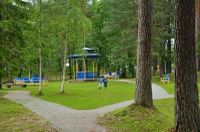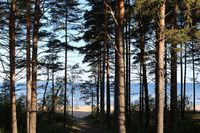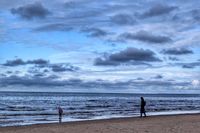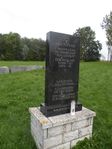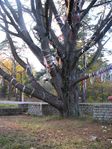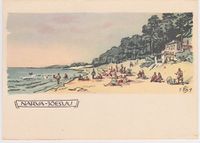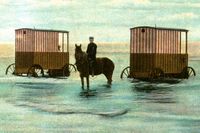Narva Jõesuu Town
>>>back to working groups overview
| Area | 11.03 km2 (4.26 sq mi) | |
| Place | Narva-Jõesuu
| |
| Country | Estonia | |
| Topics | Coastal Line study of Narva-Jõesuu | |
| Author(s) | Anne, Erki & Rajen | |
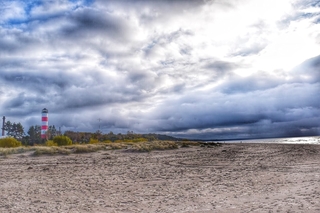 Narva-Jõesuu beach Narva-Jõesuu beach
| ||
Rationale
Narva-Jõesuu is a city with the longest sand beach in Estonia. It is located on the border with Russia and also close to Finland, being the closest touristic coast for tourist. Beautiful nature and landscape give the city a high potential but it is also challenging with depopulation and some pollution from the river.
Location and scope
You can edit this map with the map editor
A Landscape System Analysis
A.1 Landscape layers and their system context
Geomorphology, landscape units and coastal typology
- Description of evolution, status quo and driving forces, is the coastal typology changing? Why is that? (approx 200 signs)
Narva-Jõesuu is a town in Ida-Viru County, in northeastern Estonia. It is located on the country's northern Baltic coast and the Gulf of Finland. The town's name in Estonian and Russian means "Mouth of the Narva", the river which forms the border with Russia. Narva-Jõesuu beach, covered with fine sand and lined with a pine forest, is well-known for its unique natural environment and is the longest one in Estonia; running 7.5 km on the south shore of the Gulf of Finland. There is 2.5 km wide foredune plain over the south which consists of fine sandy deposits forming approximately 80 parallel ridges built by wave action and of sinuous irregular ridges formed by a combination of wave and aeolian processes. Likewise, the coastline is been modified by floating peat islands from the river that are washed to the shore by the water currents and wind movements. This phenomenon is caused by the construction of Narva hydroelectric station in 1950, which in order to be built a big swamp was flooded.
Land use
- settlements, infrastructure, agriculture, resource extraction, natural areas, energy production...
The settlement arose around the 14th century, It was the site of an outer harbour of the City of Narva from the 16th century, containing several timber stockyards, sawmills, and a small shipbuilding industry. Narva is a melting pot of Estonian and Russian cultures and a great place to stop and relax when travelling to and from St. Petersburg. The first spa in Narva-Jõesuu was opened in the 19th century, beginning a fine and well established tradition. Once a prime example of Baroque architecture in Europe, the town was heavily damaged in the Second war and almost entirely rebuilt. In the last few years its resort facilities have been renovated and thanks to its eight-kilometre-long white sand beach lined with pine tres, Narva-Jõesuu has become a popular summer destination.
- description of evolution, status quo and driving forces, is the land use likely to change? Why is that? (approx 200 signs)
- add 1-2 graphical representations to the image gallery, you can add more if you like
- Yourcase landuse1.jpg
add a caption
- Yourcase landscapeunits2.jpg
add a caption
Green/blue infrastructure
- What are the major potential elements of a green/blue infrastructure network? Are these likely to change/disappear? Why is that?
- You find my background material on green infrastructure in our reading list
- add 1-2 graphical representations to the image gallery, you can add more if you like
Actors and stakeholders
- Who is driving changes in this landscape? Who is affected by those changes?
- Draw a stakeholder and/or power map: Who is affected highly but with low power? Who has high power but is not affected?
- Your case your powermap.jpg
add a caption
Sacred spaces and heritage
- Which places/elements hold cultural value and to whom?
- You may add a map and some images, please also explain in your caption why these elements are valuable
Coastal heritage are viewed as keepers of biological diversity and sources of information about the activities of our ancestors. As this site Narva-Joesuu is a border between different nations, it has cultural value from 19th century which is rich in seafaring related heritage; sheds for nets and boats, lighthouse, rescue stations, military defence structures etc. Baltic sea and especially gulf of Finland are considered to be two of the most mine-fested water bodies in the world. Narva-Joesuu is also famous for spas and is the best holiday destination in summer since 19th century.
Some of the sacred spaces around the Nrava-joesuu;
1) Church of the Kazan Icon of the Mother of God- The distinguished wooden church has been constructed in 1893 in Meriküla. It was placed to its present location after World War II.
2) The memorial stone of the landing troops of Meriküla - This was the place where the Soviet landing troops of more than 500 men landed in February 14, 1944. The landing troops were caught by the nazi fire and most men were killed.
3) Pine of Meriküla - Meriküla pine is a nature conservation native tree in Ida-Viru county, Narva-Jõesuu. The pine is a multifloral tree that is an unusual shrub-like owl. The painter Ivan Šiškin, who was resting between Narva-Jõesuu and Udri, loved to sit and paint under this tree.
Visual appearance and landscape narrative
- Which elements are essential for the landscape character?
- Has the landscape been painted or otherwise depicted, when and whom? Which elements are essential?
- Which narratives exist? Who has written about this landscape or depicted it in some way?
- You can add text and images
Essential elements of the landscape character are the fine sand covered beach lined with pine forest, river mouth, and the sea. The landscapes in Narva-Jõesuu have not been painted very much but there are a few paintings and postcards exhibiting the sandy beach, sea and pine forests. On the city border grows a big pine tree with spreading branches under which famous Russian painter Ivan Šiškin loved to sit and paint. Šiškin has a few paintings of the pine and the surroundings exhibited in Saint Petersburg’s museum. There is a legend about Meriküla pine that couples who kiss under it will stay together forever.
A.2 Summary of you landscape system analysis and your development Targets
- You can summarize your findings with an DPSI(R) Model or a Spider Diagram
- Link back to the Sustainable Development Goals: Which goals are at risk?
- What is your hypothesis for this landscape?
- Visualise your hypothesis with one graphic/pict
- Are there any existing initiatives taking action in this landscape? Do you have a critical perspective on that?
- Add text and visuals
- Your case your spider diagram or dpsir model.jpg
explain your analysis briefly in the caption
- Your case your hypothesis visual.jpg
explain your hypthesis briefly in the caption
A.3 Theory reflection
- Reflect on at least three international policy documents in relation to their local landscape case
- choose one international, one European and one national document
- You can choose references from our reading list
- Scope: 250 words
A.4 References
- give a full list of the references you have used for this section
http://entsyklopeedia.ee/artikkel/narva-j%C3%B5esuu3 http://forte.delfi.ee/news/juskegaavastamas/jaak-juskega-kadunud-eestit-avastamas-koige-kaunima-rannaga-kodumaise-kuurordi-ehk-naljalinna-lugu?id=77744456 https://dea.digar.ee/cgi-bin/dea?a=d&d=narvajoesuu20130701.2.4 https://et.wikipedia.org/wiki/Merik%C3%BCla_m%C3%A4nd
Phase B: Landscape Evaluation and Assessment
B.1 Assessment Strategy
- Based on the hypothesis derived from your previous landscape systems analysis you are now asked to define the goals for assessing the landscape. Your assessment is the basis for evaluating the landscape status.
- Which elements and phenomena need to be mapped, why and how?
- This a text contribution, max 250 words
B.2 Mapping
- As defined by your assessment strategy you conduct the mapping and present your findings here
- As a minimum, at least three different themes need to be mapped, you may choose more if needed
- Your case your assessment mapping themel.jpg
briefly explain the findings of your mapping
- Your case your assessment mapping theme2.jpg
briefly explain the findings of your mapping
- Your case your assessment mapping theme3.jpg
briefly explain the findings of your mapping
B.3 Problem definition and priority setting
- Give a summary of the major findings of your mapping process, what are the problems/potentials identified?
- Draw a problems/potentials map
- Set priorities for the most relevant issues
- Your case problems potentials map.jpg
add caption here
B.4 Theory reflection
- Please reflect the assessment and evaluation methods used based on at least three readings
- Did you encounter limitations'
- 200 words test contribution
B.5 References
- give a full list of the references you have used for this section
Phase C – Strategy and Master Plan
C.1 Goal Setting
- Define strategic planning objectives based on the evaluation findings
- Link back to your original targets from section one and the Development Goals
- 150 words text contribution
C.2 Spatial Strategy and Transect
- translate your strategic goals into a vision
- develop a spatial translation of your vision
- exemplify your vision in the form of a transect with concrete interventions
- add map(s) and visualizations
- Your case spatial translaton vision.jpg
add caption here
- Your case transect.jpg
add caption here
- Your case transect detail1.jpg
add caption here
- Your case transect detail2.jpg
add caption here
C.3 From Theory of Change to Implementation
- For implementing your vision: Which partnerships are needed? Which governance model is required?
- Who needs to act and how? Draw and explain a change/process model/timeline
- Which resources are needed? On which assets can you build?
- add 150 words text and visuals
- Your case spatial your governance model.jpg
add caption here
- Your case spatial your process model.jpg
add caption here
C.4 References
- give a full list of the references you have used for this section
D. Process Reflection
- Reflect in your intercultural and interdisciplinary team on the outcomes of your study
- Which limitations were you facing?
- What have you learnt from each other?
- What would you do differently next time?
- You can also use diagrams/visuals
- 250 words text


